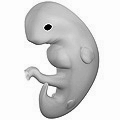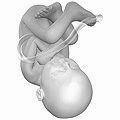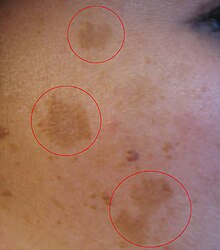Childbirth
A woman is considered to be in labour when she begins experiencing regular uterine contractions, accompanied by changes of her cervix — primarily effacement and dilation. While childbirth is widely experienced as painful, some women do report painless labours, while others find that concentrating on the birth helps to quicken labour and lessen the sensations. Most births are successful vaginal births, but sometimes complications arise and a woman may undergo a cesarean section.
During the time immediately after birth, both the mother and the baby are hormonally cued to bond, the mother through the release of oxytocin, a hormone also released during breastfeeding.
Most pregnant women experience a number of symptoms, which can signify pregnancy. The symptoms can include nausea and vomiting, excessive tiredness and fatigue, cravings for certain foods that are not normally sought out, and frequent urination particularly during the night.
A number of early medical signs are associated with pregnancy. These signs typically appear, if at all, within the first few weeks after conception. Although not all of these signs are universally present, nor are all of them diagnostic by themselves, taken together they make a presumptive diagnosis of pregnancy. These signs include the presence of human chorionic gonadotropin (hCG) in the blood and urine, missed menstrual period, implantation bleeding that occurs at implantation of the embryo in the uterus during the third or fourth week after last menstrual period, increased basal body temperature sustained for over 2 weeks after ovulation, Chadwick's sign (darkening of the cervix, vagina, and vulva), Goodell's sign (softening of the vaginal portion of the cervix), Hegar's sign (softening of the uterus isthmus), and pigmentation of linea alba – Linea nigra, (darkening of the skin in a midline of the abdomen, caused by hyperpigmentation resulting from hormonal changes, usually appearing around the middle of pregnancy). Breast tenderness is common during the first trimester, and is more common in women who are pregnant at a young age.
Pregnancy detection can be accomplished using one or more various pregnancy tests, which detect hormones generated by the newly formed placenta. Clinical blood and urine tests can detect pregnancy 12 days after implantation. Blood pregnancy tests are more accurate than urine tests. Home pregnancy tests are urine tests, and normally cannot detect a pregnancy until at least 12 to 15 days after fertilization. A quantitative blood test can determine approximately the date the embryo was conceived.
In the post-implantation phase, the blastocyst secretes a hormone named human chorionic gonadotropin, which in turn stimulates the corpus luteum in the woman's ovary to continue producing progesterone. This acts to maintain the lining of the uterus so that the embryo will continue to be nourished. The glands in the lining of the uterus will swell in response to the blastocyst, and capillaries will be stimulated to grow in that region. This allows the blastocyst to receive vital nutrients from the woman.
Despite all the signs, some women may not realize they are pregnant until they are quite far along in their pregnancy. In some cases, a few women have not been aware of their pregnancy until they begin labour. This can be caused by many factors, including irregular periods (quite common in teenagers), certain medications (not related to conceiving children), and obese women who disregard their weight gain. Others may be in denial of their situation.
An early obstetric ultrasonography can determine the age of the pregnancy fairly accurately. In practice, doctors typically express the age of a pregnancy (i.e., an "age" for an embryo) in terms of "menstrual date" based on the first day of a woman's last menstrual period, as the woman reports it. Unless a woman's recent sexual activity has been limited, she has been charting her cycles, or the conception is the result of some types of fertility treatment (such as IUI or IVF), the exact date of fertilization is unknown. Without symptoms such as morning sickness, often the only visible sign of a pregnancy is an interruption of the woman's normal monthly menstruation cycle, (i.e., a "late period"). Hence, the "menstrual date" is simply a common educated estimate for the age of a fetus, which is an average of 2 weeks later than the first day of the woman's last menstrual period. The term "conception date" may sometimes be used when that date is more certain, though even medical professionals can be imprecise with their use of the two distinct terms. The due date can be calculated by using Naegele's rule. The expected date of delivery may also be calculated from sonogram measurement of the fetus. This method is slightly more accurate than methods based on LMP. Additional obstetric diagnostic techniques can estimate the health and presence or absence of congenital diseases at an early stage.
Diagnostic criteria are: Women who have menstrual cycles and are sexually active, a period delayed by a few days or weeks is suggestive of pregnancy; elevated B-hcG to around 100,000 mIU/mL by 10 weeks of gestation.[citation needed]
Electrical brain activity is first detected between the 5th and 6th week of gestation, though this is still considered primitive neural activity rather than the beginning of conscious thought, something that develops much later in fetation. Synapses begin forming at 17 weeks, and at about week 28 begin to multiply at a rapid pace which continues until 3–4 months after birth.
One way to observe prenatal development is via ultrasound images. Modern 3D ultrasound images provide greater detail for prenatal diagnosis than the older 2D ultrasound technology. While 3D is popular with parents desiring a prenatal photograph as a keepsake, both 2D and 3D are discouraged by the FDA for non-medical use,[dead link] but there are no definitive studies linking ultrasound to any adverse medical effects. The following 3D ultrasound images were taken at different stages of pregnancy:
Some people are confused about the differences between an ultrasound
and a sonogram. An ultrasound is the actual machine that lets you
observe pregnancy. A sonogram is the image of the embryo that the
ultrasound produces. 4D Ultrasounds take 3D sonograms. Some people refer
to the procedure as prenatal imaging, 3D imaging, a 3D scan, or 4D
scan.
Adequate periconceptional folic acid (also called folate or Vitamin B9) intake has been proven to limit fetal neural tube defects, preventing spina bifida, a very serious birth defect. The neural tube develops during the first 28 days of pregnancy, explaining the necessity to guarantee adequate periconceptional folate intake. Folates (from folia, leaf) are abundant in spinach (fresh, frozen, or canned), and are found in green leafy vegetables e.g. salads, beets, broccoli, asparagus, citrus fruits and melons, chickpeas (i.e. in the form of hummus or falafel), and eggs. In the United States and Canada, most wheat products (flour, noodles) are fortified with folic acid.
DHA omega-3 is a major structural fatty acid in the brain and retina, and is naturally found in breast milk. It is important for the woman to consume adequate amounts of DHA during pregnancy and while nursing to support her well-being and the health of her infant. Developing infants cannot produce DHA efficiently, and must receive this vital nutrient from the woman through the placenta during pregnancy and in breast milk after birth.
Several micronutrients are important for the health of the developing fetus, especially in areas of the world where insufficient nutrition is prevalent. In developed areas, such as Western Europe and the United States, certain nutrients such as Vitamin D and calcium, required for bone development, may require supplementation. A 2011 study examined cord blood of healthy neonates and found that low levels of vitamin D are associated with increased risk of lower respiratory tract infection the first year of life.
Dangerous bacteria or parasites may contaminate foods, particularly Listeria and toxoplasma, toxoplasmosis agent. Careful washing of fruits and raw vegetables may remove these pathogens, as may thoroughly cooking leftovers, meat, or processed meat. Soft cheeses may contain Listeria; if milk is raw, the risk may increase. Cat feces pose a particular risk of toxoplasmosis. Pregnant women are also more prone to Salmonella infections from eggs and poultry, which should be thoroughly cooked. Practicing good hygiene in the kitchen can reduce these risks.
Main article: Childbirth
Childbirth is the process whereby an infant is born. It is considered
to be the beginning of the infant's life, and age is defined relative
to this event in most cultures.A woman is considered to be in labour when she begins experiencing regular uterine contractions, accompanied by changes of her cervix — primarily effacement and dilation. While childbirth is widely experienced as painful, some women do report painless labours, while others find that concentrating on the birth helps to quicken labour and lessen the sensations. Most births are successful vaginal births, but sometimes complications arise and a woman may undergo a cesarean section.
During the time immediately after birth, both the mother and the baby are hormonally cued to bond, the mother through the release of oxytocin, a hormone also released during breastfeeding.
Diagnosis
The beginning of pregnancy may be detected in a number of different ways, either by a pregnant woman without medical testing, or by using medical tests with or without the assistance of a medical professional.Most pregnant women experience a number of symptoms, which can signify pregnancy. The symptoms can include nausea and vomiting, excessive tiredness and fatigue, cravings for certain foods that are not normally sought out, and frequent urination particularly during the night.
A number of early medical signs are associated with pregnancy. These signs typically appear, if at all, within the first few weeks after conception. Although not all of these signs are universally present, nor are all of them diagnostic by themselves, taken together they make a presumptive diagnosis of pregnancy. These signs include the presence of human chorionic gonadotropin (hCG) in the blood and urine, missed menstrual period, implantation bleeding that occurs at implantation of the embryo in the uterus during the third or fourth week after last menstrual period, increased basal body temperature sustained for over 2 weeks after ovulation, Chadwick's sign (darkening of the cervix, vagina, and vulva), Goodell's sign (softening of the vaginal portion of the cervix), Hegar's sign (softening of the uterus isthmus), and pigmentation of linea alba – Linea nigra, (darkening of the skin in a midline of the abdomen, caused by hyperpigmentation resulting from hormonal changes, usually appearing around the middle of pregnancy). Breast tenderness is common during the first trimester, and is more common in women who are pregnant at a young age.
Pregnancy detection can be accomplished using one or more various pregnancy tests, which detect hormones generated by the newly formed placenta. Clinical blood and urine tests can detect pregnancy 12 days after implantation. Blood pregnancy tests are more accurate than urine tests. Home pregnancy tests are urine tests, and normally cannot detect a pregnancy until at least 12 to 15 days after fertilization. A quantitative blood test can determine approximately the date the embryo was conceived.
In the post-implantation phase, the blastocyst secretes a hormone named human chorionic gonadotropin, which in turn stimulates the corpus luteum in the woman's ovary to continue producing progesterone. This acts to maintain the lining of the uterus so that the embryo will continue to be nourished. The glands in the lining of the uterus will swell in response to the blastocyst, and capillaries will be stimulated to grow in that region. This allows the blastocyst to receive vital nutrients from the woman.
Despite all the signs, some women may not realize they are pregnant until they are quite far along in their pregnancy. In some cases, a few women have not been aware of their pregnancy until they begin labour. This can be caused by many factors, including irregular periods (quite common in teenagers), certain medications (not related to conceiving children), and obese women who disregard their weight gain. Others may be in denial of their situation.
An early obstetric ultrasonography can determine the age of the pregnancy fairly accurately. In practice, doctors typically express the age of a pregnancy (i.e., an "age" for an embryo) in terms of "menstrual date" based on the first day of a woman's last menstrual period, as the woman reports it. Unless a woman's recent sexual activity has been limited, she has been charting her cycles, or the conception is the result of some types of fertility treatment (such as IUI or IVF), the exact date of fertilization is unknown. Without symptoms such as morning sickness, often the only visible sign of a pregnancy is an interruption of the woman's normal monthly menstruation cycle, (i.e., a "late period"). Hence, the "menstrual date" is simply a common educated estimate for the age of a fetus, which is an average of 2 weeks later than the first day of the woman's last menstrual period. The term "conception date" may sometimes be used when that date is more certain, though even medical professionals can be imprecise with their use of the two distinct terms. The due date can be calculated by using Naegele's rule. The expected date of delivery may also be calculated from sonogram measurement of the fetus. This method is slightly more accurate than methods based on LMP. Additional obstetric diagnostic techniques can estimate the health and presence or absence of congenital diseases at an early stage.
Diagnostic criteria are: Women who have menstrual cycles and are sexually active, a period delayed by a few days or weeks is suggestive of pregnancy; elevated B-hcG to around 100,000 mIU/mL by 10 weeks of gestation.[citation needed]
Embryonic and fetal development and ultrasound imaging
See also: Prenatal development
See also: Obstetric ultrasonography
Prenatal development is divided into two primary biological stages. The first is the embryonic stage, which lasts for about two months. At this point, the fetal stage begins. At the beginning of the fetal stage, the risk of miscarriage decreases sharply,
all major structures including the head, brain, hands, feet, and other
organs are present, and they continue to grow and develop. When the
fetal stage commences, a fetus is typically about 30 mm (1.2 inches) in
length, and the heart can be seen beating via ultrasound; the fetus can
be seen making various involuntary motions at this stage.Electrical brain activity is first detected between the 5th and 6th week of gestation, though this is still considered primitive neural activity rather than the beginning of conscious thought, something that develops much later in fetation. Synapses begin forming at 17 weeks, and at about week 28 begin to multiply at a rapid pace which continues until 3–4 months after birth.
-
 Fetus at 18 weeks after fertilization
Fetus at 18 weeks after fertilization
-
 Relative size in 1st month (simplified illustration)
Relative size in 1st month (simplified illustration)
-
 Relative size in 3rd month (simplified illustration)
Relative size in 3rd month (simplified illustration)
-
 Relative size in 5th month (simplified illustration)
Relative size in 5th month (simplified illustration)
-
 Relative size in 9th month (simplified illustration)
Relative size in 9th month (simplified illustration)
-
 75-mm fetus (about 14 weeks gestational age)
75-mm fetus (about 14 weeks gestational age)
-
 Fetus at 17 weeks
Fetus at 17 weeks
-
 Fetus at 20 weeks
Fetus at 20 weeks
Physiological changes
Main article: Maternal physiological changes in pregnancy
During pregnancy, the woman undergoes many physiological changes, which are entirely normal, including cardiovascular, hematologic, metabolic, renal and respiratory
changes that become very important in the event of complications. The
body must change its physiological and homeostatic mechanisms in
pregnancy to ensure the fetus is provided for. Increases in blood sugar,
breathing and cardiac output are all required. Levels of progesterone
and oestrogens rise continually throughout pregnancy, suppressing the
hypothalamic axis and subsequently the menstrual cycle. The woman and
the placenta also produce many hormones.Management
Main article: Prenatal care
Prenatal medical care is the medical and nursing care recommended for
women before and during pregnancy. The aim of good prenatal care is to
detect any potential problems early, to prevent them if possible
(through recommendations on adequate nutrition, exercise, vitamin intake
etc.), and to direct the woman to appropriate specialists, hospitals,
etc. if necessary.Nutrition
Main article: Nutrition and pregnancy
A balanced, nutritious diet is an important aspect of a healthy pregnancy. Eating a healthy diet, balancing carbohydrates, fat, and proteins, and eating a variety of fruits and vegetables,
usually ensures good nutrition. Those whose diets are affected by
health issues, religious requirements, or ethical beliefs may choose to
consult a health professional for specific advice.Adequate periconceptional folic acid (also called folate or Vitamin B9) intake has been proven to limit fetal neural tube defects, preventing spina bifida, a very serious birth defect. The neural tube develops during the first 28 days of pregnancy, explaining the necessity to guarantee adequate periconceptional folate intake. Folates (from folia, leaf) are abundant in spinach (fresh, frozen, or canned), and are found in green leafy vegetables e.g. salads, beets, broccoli, asparagus, citrus fruits and melons, chickpeas (i.e. in the form of hummus or falafel), and eggs. In the United States and Canada, most wheat products (flour, noodles) are fortified with folic acid.
DHA omega-3 is a major structural fatty acid in the brain and retina, and is naturally found in breast milk. It is important for the woman to consume adequate amounts of DHA during pregnancy and while nursing to support her well-being and the health of her infant. Developing infants cannot produce DHA efficiently, and must receive this vital nutrient from the woman through the placenta during pregnancy and in breast milk after birth.
Several micronutrients are important for the health of the developing fetus, especially in areas of the world where insufficient nutrition is prevalent. In developed areas, such as Western Europe and the United States, certain nutrients such as Vitamin D and calcium, required for bone development, may require supplementation. A 2011 study examined cord blood of healthy neonates and found that low levels of vitamin D are associated with increased risk of lower respiratory tract infection the first year of life.
Dangerous bacteria or parasites may contaminate foods, particularly Listeria and toxoplasma, toxoplasmosis agent. Careful washing of fruits and raw vegetables may remove these pathogens, as may thoroughly cooking leftovers, meat, or processed meat. Soft cheeses may contain Listeria; if milk is raw, the risk may increase. Cat feces pose a particular risk of toxoplasmosis. Pregnant women are also more prone to Salmonella infections from eggs and poultry, which should be thoroughly cooked. Practicing good hygiene in the kitchen can reduce these risks.






No comments:
Post a Comment